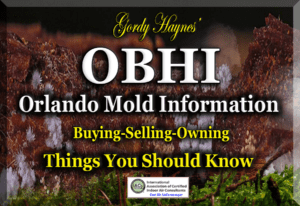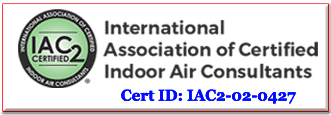Orlando Mold Inspection

Orlando Mold Inspection | What You Need To Know About Mold…
An understanding about Orlando Mold Inspection is critical to a healthy home and indoor air quality.
What is mold, where is it found, how to correct mold problems and how to prevent mold issues.
Molds are part of the environments we live, work and play in. They are essentially, everywhere. Outside and inside our homes. It is when mold has a moisture source that growth begins.
What Is Mold?
Molds include all species of microscopic fungi that grow in the form of multicellular filaments, called hyphae. Molds can thrive on any organic matter, including clothing, leather, paper, and the ceilings, walls and floors of homes with moisture management problems. Mildew often lives on shower walls, windowsills, and other places where moisture levels are high. There are many species of molds. In unaired places, such as basements, they can produce a strong musty odor. One mold of particular concern is Stachybotrys chartarum is a greenish-black mold. It can grow on material with a high cellulose content, such as fiberboard, gypsum board, and paper. Growth occurs when there is moisture from water damage, water leaks, condensation, water infiltration, or flooding. Constant moisture is required for its growth.
Mold can never be completely eliminated. The key to resolving a mold problem, is to identifying and controlling the moisture source that encourages its growth.
There are many types of molds and some can potentially create very serious health issues. The reaction to mold exposure varies from person to person. At the end of the day, however, you should control the mold in your home to have a better, healthier indoor air quality.
If you have respiratory issues like emphysema, asthma, allergies and so on, you should be especially diligent in addressing any mold issues in your home. Healthy indoor air quality is so important to us all.
Where Is The Mold?
Mold can very difficult to locate and it can grow and flourish in unseen areas.
Like:
- Behind and within walls
- Behind wallpaper
- Under bathroom and kitchen cabinet
- Under carpet and padding
- In your HVAC system;
- Air handler
- Ductwork
Where Does The Moisture Come From?
Moisture sources can be obvious or not. For example, if you have a flood in your home from backed up shower or toilet, a busted pipe, washing machine floods, etc., you can see those water issues.
But things like a negative grade around your home’s perimeter, a small roof leak, plumbing pipe under your slab or pinhole leak in the wall, excessive humidity, mold growth behind wallpaper, under carpets, etc., you may have no idea there’s a mold issues.
Mold within a very small area, less than 10 square feet, for example, may be addressed by a home owner. You can see EPA recommendation here. However, larger areas or smells that seem suspicious, should be assessed, and action protocols developed and advised by a licensed professional.
How to correct a mold problem
As noted above, small areas less than 10 square feet, a home owner can clean it up, correct the moisture source. But for larger areas, we recommend the services of a licensed professional.
That could be a licensed mold assessor or Industrial Hygienist. Home inspectors, for example, may offer to test limited areas of a suspected area or material. That generally involves a contact sample or air sample that is taken, then, sent to an accredited laboratory for analysis.
You would then get the report from the lab and at that point, decide what your next step will be. Do-it-yourself or hire a licensed professional.
So our advice is, for larger areas, get a licensed mold assessor or Industrial Hygienist. They are experienced, insured and can write a protocol for the mold remediation you may need.
Tips And Recommendations To Help Retard Mold Issues
Keep your indoor humidity around 30 to 50%
Keep your bathroom adequately ventilated, window or high-volume exhaust fan
Maintain all your plumbing pipes, supply, drains and venting
Maintain all your plumbing fixtures, correct, or replace any leaking fixtures
Make sure you don’t have a negative grade that is holding moisture around your home’s perimeter
Look for and prevent indoor condensation issues
Have your HVAC contractor ensure you don’t have a condensate issue within your HVAC air handler cabinet, ask him also, about a UV light to help retard organic growth
Keep your roof well maintained to ensure you have no leaks
Get an annual Orlando Home Maintenance Inspection form Orlando’s Best Home Inspection, LLC
Gordy was one of the first licensed mold assessors in the state of Florida (MRAS106) and still maintains his licensed as an inactive status today. At OBHI, we do not offer mold testing.
We don’t offer the testing, or sampling because there’s simply too great of a potential for error, liability and incorrect assessment over all, when only a 10 square foot area can be considered. And, if a sample should come back with an elevated mold count, you would then need a licensed mold assessment.
A process that would require repeated sampling and repeated spending on the client’s part just to have licensed hygienist or mold assessor write a protocol for the next professional and process, a mold remediator and/or others.
The most import advice OBHI can give a home owner or prospective buyer is this;
If you see or suspect a potential mold issue, if your home inspector sees or suspects a possible organic concern, get a state licensed mold assessor or industrial hygienist to do an assessment. They are the ones licensed, properly insured and qualified to advise you on mold issues, assessment and remediation protocols.
Think about it for a minute…the decisions you make are so important to you and your family. You wouldn’t ask your dentist to advise you on heart papulations. Get your potential or suspected mold concerns addressed by a licensed mold assessor.
Additional Orlando Mold Inspection Resources
Here are additional Orlando mold inspection and information links for more detailed information concerning Orlando Mold Issues, what you should know.
https://www.epa.gov/mold/printable-version-brief-guide-mold-moisture-and-your-home
We Have Two Referrals For Mold Assessments. Call Us For Information
Call Gordy
407.461.8825
Orlando’s Best Home Inspection, LLC
Orlando, Fl 32806
Email:
Requesthomeinspection@gmail.com
